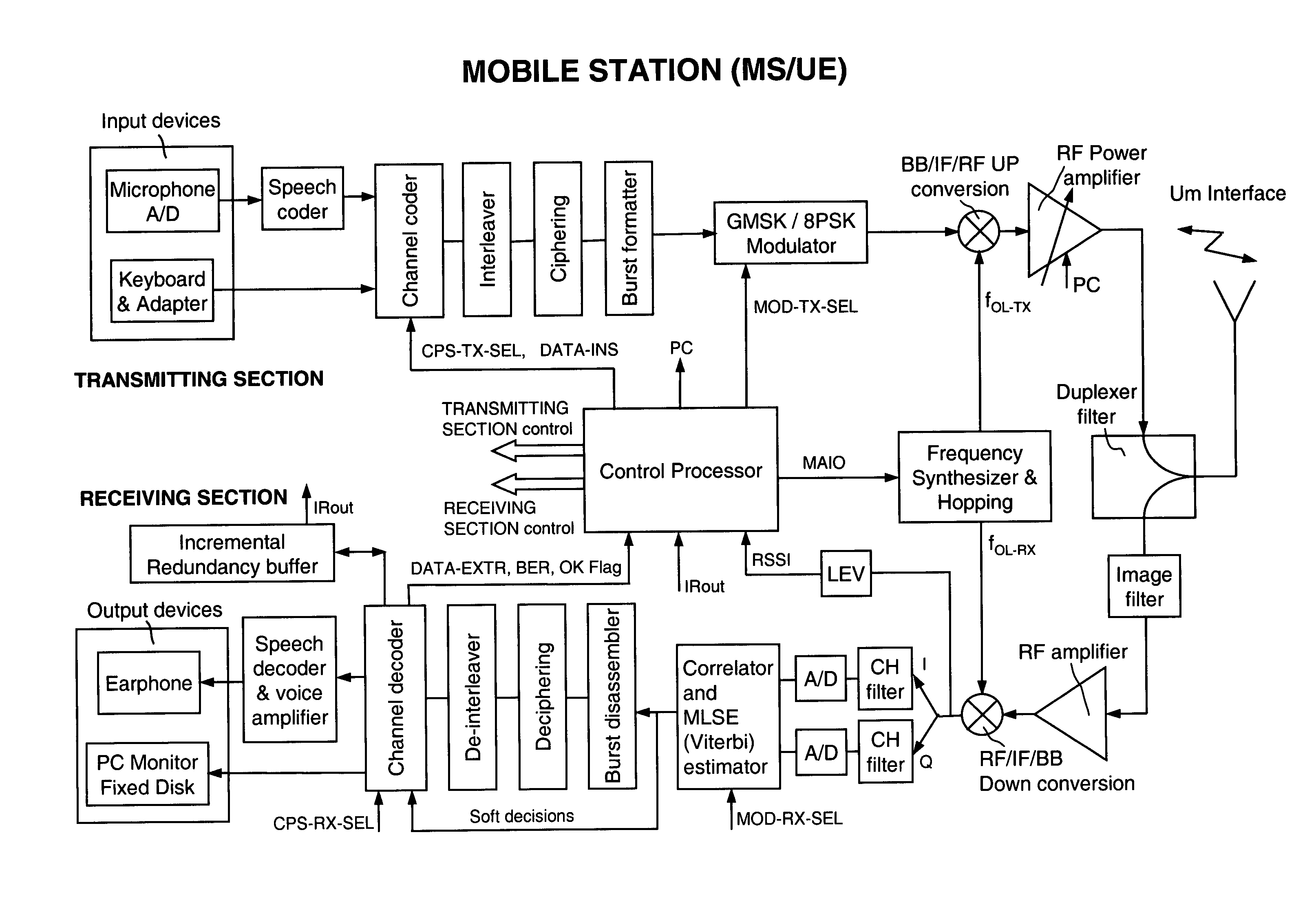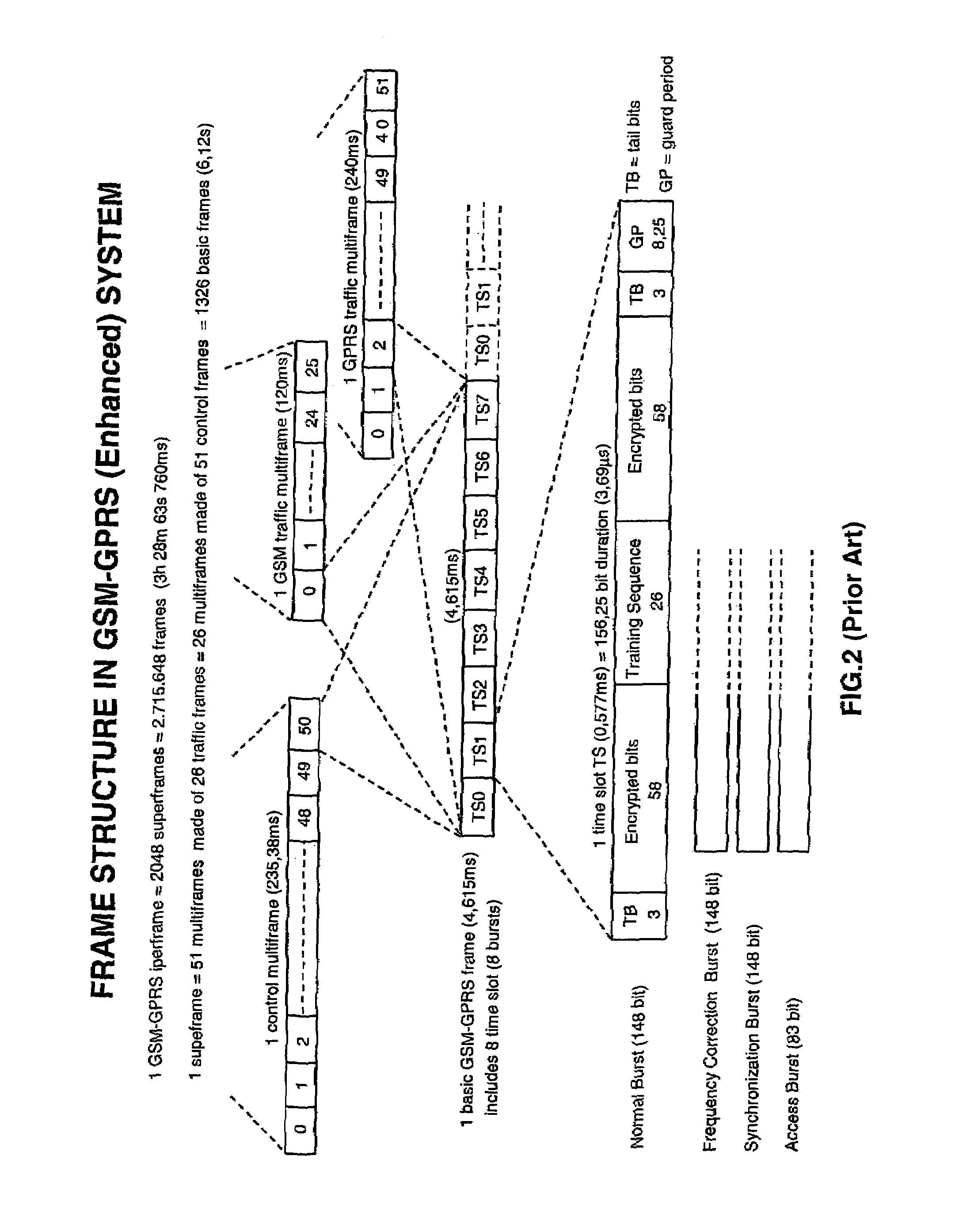[0045]TABLE 2 of the APPENDIX shows:
code rate,
data rate, number of coding bits, etc. concerning EGPRS MCS-1 to MCS-9 schemes. In TABLE 2 the column HCS means Header Check Sequence, while the column Family will be explained later. New EGPRS service thanks to the nine MCSi combinations offers several more opportunities for packet
data link adaptation. From TABLE 2 it can be observed that for each type of modulation the grater the code-rate, the greater is the data-rate, because code-rate represents the ratio between the number of useful bits in the source sequence and the number of coded bits. Considering burst having
fixed length it results that the higher the code-rate, the poorest is the protection against errors. Higher level modulations (like 8-PSK) are more sensible than lower level modulations (like GMSK) to the causes of RF link degradation and similarly higher code-rates in comparison with lower code rates. Greater sensibility also means faster worsening of the
signal delivered to the users as the quality of the RF link worsen. Nevertheless the enhanced opportunity to select one out several combinations of modulation and coding schemes (MCS), enables the
system to switch among the various MCSs during run-time to combat the variability of the RF channel.
Link adaptation is just this behavior! TABLE 2 doesn't limit the present invention which is valid also in presence of different high level modulations variously combined with the same or different coding schemes.
[0080]To achieve said objects the subject of the present invention is a method for dynamically optimize data
throughput at the radio interfaces of a packet data
cellular network. The method of the invention provides an additional set of tabulated thresholds for considering RF channels with
high variability. The additional set is particularly appreciable in presence of frequency hopping, that because the new thresholds provided for the BLER comparison better fit with the effects of an increased variability of the RF channel due to the frequency hopping. The two sets of tabulated thresholds, for channels with or without frequency hopping might be preferably both allocated to the BSS (PCU) and either enabled in the occurrence.
[0081]The approach taken for frequency hopping is extended to consider all the possible practical RF scenarios. It has been noticed that the
simulation results can be grouped into few significant cases. For instance in a typical
urban environment two only different cases can be taken into account:, namely: a “low diversity”
scenario and a “high diversity”
scenario. A first set of thresholds for the “low diversity”
scenario should be selected if the
cell is characterized by a low user mobility, such as: pico-cells, indoor cells, etc., without Frequency Hopping. A second set of thresholds for the “high diversity” scenario should be selected instead if the
cell is characterized by a higher user mobility, such as: ≈50 km / h mobile speed, or if Frequency Hopping is enabled. The method of the present invention provides the two set of thresholds for “high diversity” and “low diversity” RF channels, in that resolving the problem of the variability of the RF channel. Relevant prior art is silent about a difference on the thresholds delimiting a BLER region characteristic of a particular modulation for taking into account low and high channel variability. Besides a link adaptation based on the only selection of different modulations doesn't offer as many opportunities as the combination of modulations with different codes.
[0082]The approach of the present invention is extended to consider the
impact of
Incremental Redundancy (IR) on
Link Adaptation (LA). The invention solves this complex technical problem starting with introducing a variable called IR_status which gives continuously updated information to the receiving entity (either the network or the
mobile station) about the efficiency of Incremental Redundancy, as disclosed in a relative dependent claim. The evaluation of the variable IR_status is quite simple and filtered IR_status values are taken to update the BLER thresholds consequently. Updating is performed by a linear interpolation between two extreme conditions, namely: BLER thresholds relative to lack of IR and BLER thresholds relative to perfect IR. Intermediate and more realistic conditions are automatically managed by the mechanism of threshold updating. The outlined contrasting behavior between LA and IR, since now remarkable source of problems in the determination of the best adaptation strategy, is no more a problem with the method of the invention extended to the Incremental Redundancy. The
impact of Incremental Redundancy is either considered for high diversity or low diversity RF channels
[0083]Last argument of the invention is a modified
Power Control algorithm having a different goal then the traditional one. The modified
algorithm attempts to maintain a C / Itarget target value for the duration of the whole TBF. The C / Itarget target is associated to a Peak
Throughput per timeslot decided as “Target performance”. The association is performed through a curve that represents the maximum achievable
Throughput versus C / I. This curve belongs to those simulated off-line during the preliminary step of the
Link Adaptation subject of the present invention, in particular to a set having care of the
incremental redundancy. Although the upper goal of
Power Control,
Link Adaptation continues to adapt to radio conditions, switching from one MCS to another, in order to optimize performance on net
throughput. This may happen due to the fact that the
power control cannot be “perfect” and therefore the actual C / I ratio may be different from the target one. From above it can be argued that the Modified
Power Control algorithm complete the Link
Adaptation of the present invention working in
synergy with it; in that resolving the outlined controversy of the traditional Power Control. Besides, contrarily to the
power control of the first cited document of the prior art, it need not separate optimization for each available MCSs.
[0084]From all the above considerations the following substantial advantages of the proposed invention emerge, namely:
[0085]link adaptation runs independently on quality measures, however performed on the ongoing RF
signal for traditional Power Control and
Handover procedures;
[0087]the memory size for Incremental Redundancy is managed in a transparent way;
 Login to View More
Login to View More  Login to View More
Login to View More 


